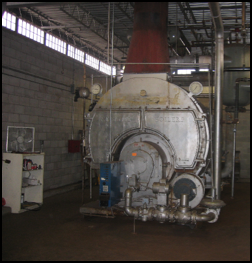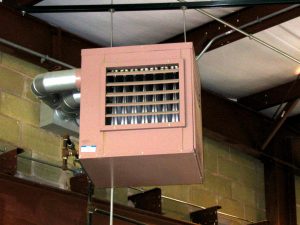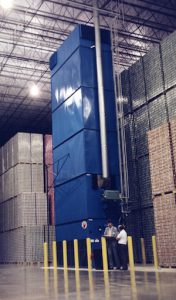Is the heating bill for your plant or warehouse too high? What about cold dock door areas and unbalanced temperatures? Is negative building pressure a problem? Do your employees complain about it being too cold making it harder for them to do their job? Do you have high maintenance costs from existing heating equipment? These are just a few common problems that result from selecting the wrong heating system, misplacing your heaters so they can’t reach their full potential or using obsolete technology. What factors determine the best space heating system? Everyone wants a heating & ventilating system that meets their unique requirements at the lowest total cost. Before selecting a heater, define the heating/ventilating requirements and understand all the cost factors that determine the true lowest total cost solution for a specific facility.
BOILER SYSTEMS
One of the oldest forms of heating, boilers have been in existence since about the 1800’s and are still a preferred  system of heating in large industrial facilities where remote plants deliver steam and hot water to satellite locations to circulate through heat exchangers. These exchangers can be part of unit heaters, make up air systems, or anywhere a heat exchanger can be installed. While huge advances in boiler technologies have evolved over the past few years, boiler systems are typically the most inefficient heating technology – with the highest overall installed cost, the highest cost to maintain and repair, and a huge level of stratification of the surrounding air. When discussing boiler replacements or supplemental heating with contractors, it’s very important to consider the overall operating and maintenance costs of these systems. Boilers require maintenance to ensure they operate at their peak efficiency. Parts such as valves, traps and fittings wear out over time. While the boiler system generates the heat, they also require a distribution system – such as unit heaters or make up air systems. A lot of mechanical components to consider.
system of heating in large industrial facilities where remote plants deliver steam and hot water to satellite locations to circulate through heat exchangers. These exchangers can be part of unit heaters, make up air systems, or anywhere a heat exchanger can be installed. While huge advances in boiler technologies have evolved over the past few years, boiler systems are typically the most inefficient heating technology – with the highest overall installed cost, the highest cost to maintain and repair, and a huge level of stratification of the surrounding air. When discussing boiler replacements or supplemental heating with contractors, it’s very important to consider the overall operating and maintenance costs of these systems. Boilers require maintenance to ensure they operate at their peak efficiency. Parts such as valves, traps and fittings wear out over time. While the boiler system generates the heat, they also require a distribution system – such as unit heaters or make up air systems. A lot of mechanical components to consider.
 UNIT HEATERS
UNIT HEATERS
The most basic of all heating technologies, unit heaters are inexpensive to purchase and have good familiarity by most contractors and engineers. The redundant design makes servicing by contractors very simple. They are fairly effective in zone heating. Unit heaters promote poor indoor air quality and huge levels of stratification in the space upwards of 20-30 degrees without adding additional HVLS fans. They offer a low temperature rise versus direct fired technologies, a higher operating cost, and cannot combat dock door infiltration.
INFRARED OR RADIANT TUBE HEATERS
While infrared or tube heaters are good for zone and spot heating applications, they should never be used as the sole source of heating large spaces. Radiant heaters offer a relatively low operating cost and a way to heat tools, work stations, and people without consuming floor space. Radiant heaters do not offer indoor air quality benefits nor any ventilation in the summer. They do not promote air mixing and have a high installation cost due to line of sight restrictions and coverage limitations.
RECIRCULATION 80/20 SYSTEMS
Recirculation systems or 80/20 systems are typically thought to be more efficient than other technologies due to the fact that a large amount, up to 80% of the air moved is recirculated, thus not requiring a large amount of gas to heat it up. Recirculation units are widely used to combat facilities with mechanical exhaust systems, especially when variable CFM is needed. They typically regulate the amount of outside air they introduce, based off the CFM needs of the building itself. Typically, fewer units are necessary and they do a decent job of providing summer ventilation. Recirculation systems are draw thru systems with a minimal effective temperature rise of about 40-50F. When dock doors are open in a facility, the recirculation units will be driven to 100% outside air and with discharge temperatures ranging between 80-100F, they must run continuously to cycle enough CFM to make up the temperature and pressure drop. The recirculation units are very large and heavy, requiring larger cranes, structural modifications, and much larger first cost and operating costs. They are not certified for use in Canada and with recirculation of air and contaminants, products of combustion can build up in the space.
 AIR TURNOVER (AIR ROTATION)
AIR TURNOVER (AIR ROTATION)
Air turnover has been marketed as a package system to industrial customers since its inception in the 1920’s. While marketed as a single piece of equipment (a large tower set in the corner of a warehouse space), the greatest advantage of air turnover is the ability to provide BOTH tempered heating and cooling to a space. Air turnover systems offer decent heating with limited stratification due to the massive volume of air they recirculate in the space. This air mass is moved due to a continuous operation and very large horse power motors driving the fans. Air turnover units provide a very low temperature rise of between 20-30 degrees and a discharge temperature of about 80-90 degrees.
DIRECT-FIRED MAKEUP AIR SYSTEMS
Direct-Fired Makeup Air units provide required ventilation to meet indoor air quality needs with efficiencies between 90-92% AFUE. Widely beneficial in buildings with fixed CFM needs due to mechanical exhaust, makeup air units provide a fixed volume of air independent of the heat they provide. With a lower discharge velocity at the plenum, air typically does not hit the floor to sweep and de-stratify the space and can lead to lower employee comfort levels. The fixed CFM blowers require larger HP motors with over-pressurization of spaces a reality. Larger motors, lower temperature rise, and less efficient design require more energy to run. While Cambridge uses our Blow-thru design of the S-Series and SA-Series heaters to heat, a lot of manufacturers use makeup air units attempting to do the same. In places where there are warmer climates and less winter cold, makeup air systems offer a way to temper the outside winter air thru a lower temperature rise of between 100° and 120°F and a draw thru design. This places the mechanical components in the hot air stream. For heating applications, we recommend our S-Series and SA-Series heaters. With a Blow-thru design, our mechanicals are in the cold air stream. The position of the blower relative to the burner and the burner’s ability to discharge 160°F, provides advantages over ANY makeup air unit – more air mass and higher temperature rise. This provides the most BTUs per CFM from any manufacturer. Cambridge’s M-series make up air units are designed to temper the air in situations where there is a lot of fixed or variable exhaust. They can be interlocked with existing exhaust fans or outfitted with variable frequency drives. Our units can come with fully modulating burners and automatic profile adjustment dampers. Hopefully, the topic we’ve outlined today will help prepare you to address any technology claim from other manufacturers. As always, feel free to contact us with any questions. We can easily accommodate lunch and learns, audio and video conferencing, phone, or face to face sales calls.